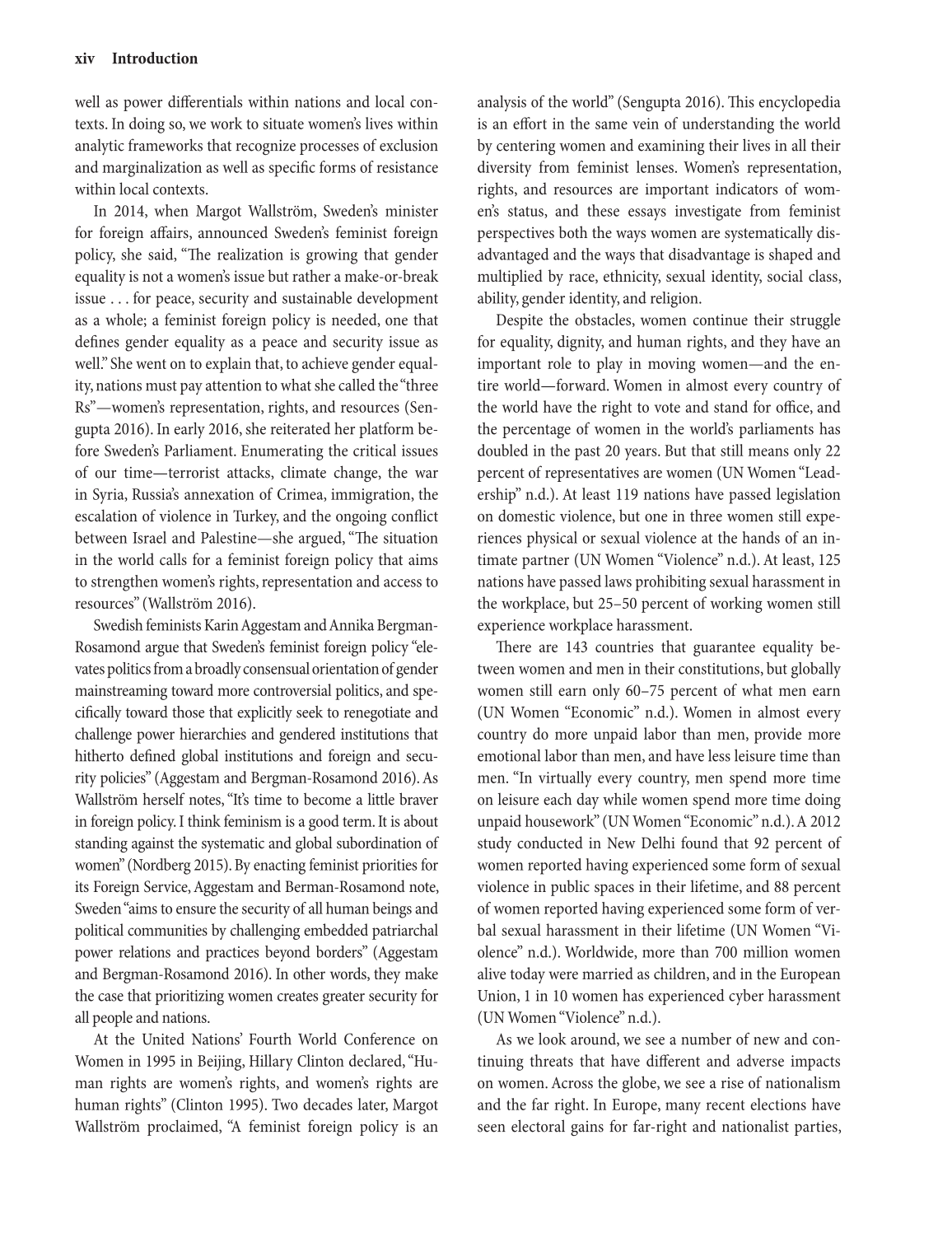xiv Introduction
well as power differentials within nations and local con-
texts. In doing so, we work to situate women’s lives within
analytic frameworks that recognize processes of exclusion
and marginalization as well as specific forms of resistance
within local contexts.
In 2014, when Margot Wallström, Sweden’s minister
for foreign affairs, announced Sweden’s feminist foreign
policy, she said, “The realization is growing that gender
equality is not a women’s issue but rather a make-or-break
issue . . . for peace, security and sustainable development
as a whole; a feminist foreign policy is needed, one that
defines gender equality as a peace and security issue as
well.” She went on to explain that, to achieve gender equal-
ity, nations must pay attention to what she called the “three
Rs”—women’s representation, rights, and resources (Sen-
gupta 2016). In early 2016, she reiterated her platform be-
fore Sweden’s Parliament. Enumerating the critical issues
of our time—terrorist attacks, climate change, the war
in Syria, Russia’s annexation of Crimea, immigration, the
escalation of violence in Turkey, and the ongoing conflict
between Israel and Palestine—she argued, “The situation
in the world calls for a feminist foreign policy that aims
to strengthen women’s rights, representation and access to
resources” (Wallström 2016).
Swedish feminists Karin Aggestam and Annika Bergman-
Rosamond argue that Sweden’s feminist foreign policy “ele-
vates politics from a broadly consensual orientation of gender
mainstreaming toward more controversial politics, and spe-
cifically toward those that explicitly seek to renegotiate and
challenge power hierarchies and gendered institutions that
hitherto defined global institutions and foreign and secu-
rity policies” (Aggestam and Bergman-Rosamond 2016). As
Wallström herself notes, “It’s time to become a little braver
in foreign policy. I think feminism is a good term. It is about
standing against the systematic and global subordination of
women” (Nordberg 2015). By enacting feminist priorities for
its Foreign Service, Aggestam and Berman-Rosamond note,
Sweden “aims to ensure the security of all human beings and
political communities by challenging embedded patriarchal
power relations and practices beyond borders” (Aggestam
and Bergman-Rosamond 2016). In other words, they make
the case that prioritizing women creates greater security for
all people and nations.
At the United Nations’ Fourth World Conference on
Women in 1995 in Beijing, Hillary Clinton declared, “Hu-
man rights are women’s rights, and women’s rights are
human rights” (Clinton 1995). Two decades later, Margot
Wallström proclaimed, “A feminist foreign policy is an
analysis of the world” (Sengupta 2016). This encyclopedia
is an effort in the same vein of understanding the world
by centering women and examining their lives in all their
diversity from feminist lenses. Women’s representation,
rights, and resources are important indicators of wom-
en’s status, and these essays investigate from feminist
perspectives both the ways women are systematically dis-
advantaged and the ways that disadvantage is shaped and
multiplied by race, ethnicity, sexual identity, social class,
ability, gender identity, and religion.
Despite the obstacles, women continue their struggle
for equality, dignity, and human rights, and they have an
important role to play in moving women—and the en-
tire world—forward. Women in almost every country of
the world have the right to vote and stand for office, and
the percentage of women in the world’s parliaments has
doubled in the past 20 years. But that still means only 22
percent of representatives are women (UN Women “Lead-
ership” n.d.). At least 119 nations have passed legislation
on domestic violence, but one in three women still expe-
riences physical or sexual violence at the hands of an in-
timate partner (UN Women “Violence” n.d.). At least, 125
nations have passed laws prohibiting sexual harassment in
the workplace, but 25–50 percent of working women still
experience workplace harassment.
There are 143 countries that guarantee equality be-
tween women and men in their constitutions, but globally
women still earn only 60–75 percent of what men earn
(UN Women “Economic” n.d.). Women in almost every
country do more unpaid labor than men, provide more
emotional labor than men, and have less leisure time than
men. “In virtually every country, men spend more time
on leisure each day while women spend more time doing
unpaid housework” (UN Women “Economic” n.d.). A 2012
study conducted in New Delhi found that 92 percent of
women reported having experienced some form of sexual
violence in public spaces in their lifetime, and 88 percent
of women reported having experienced some form of ver-
bal sexual harassment in their lifetime (UN Women “Vi-
olence” n.d.). Worldwide, more than 700 million women
alive today were married as children, and in the European
Union, 1 in 10 women has experienced cyber harassment
(UN Women “Violence” n.d.).
As we look around, we see a number of new and con-
tinuing threats that have different and adverse impacts
on women. Across the globe, we see a rise of nationalism
and the far right. In Europe, many recent elections have
seen electoral gains for far-right and nationalist parties,
















































































































































































































































































































































































































































































































































































































































































































































































































































































































































































































































































































































































































































































































































































































































































































































































































































































































































































































































































































